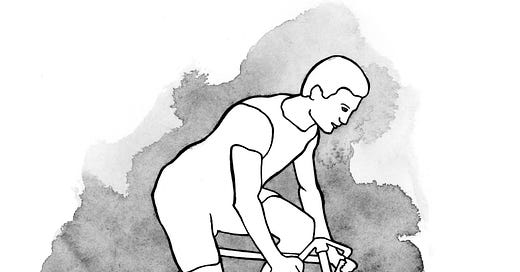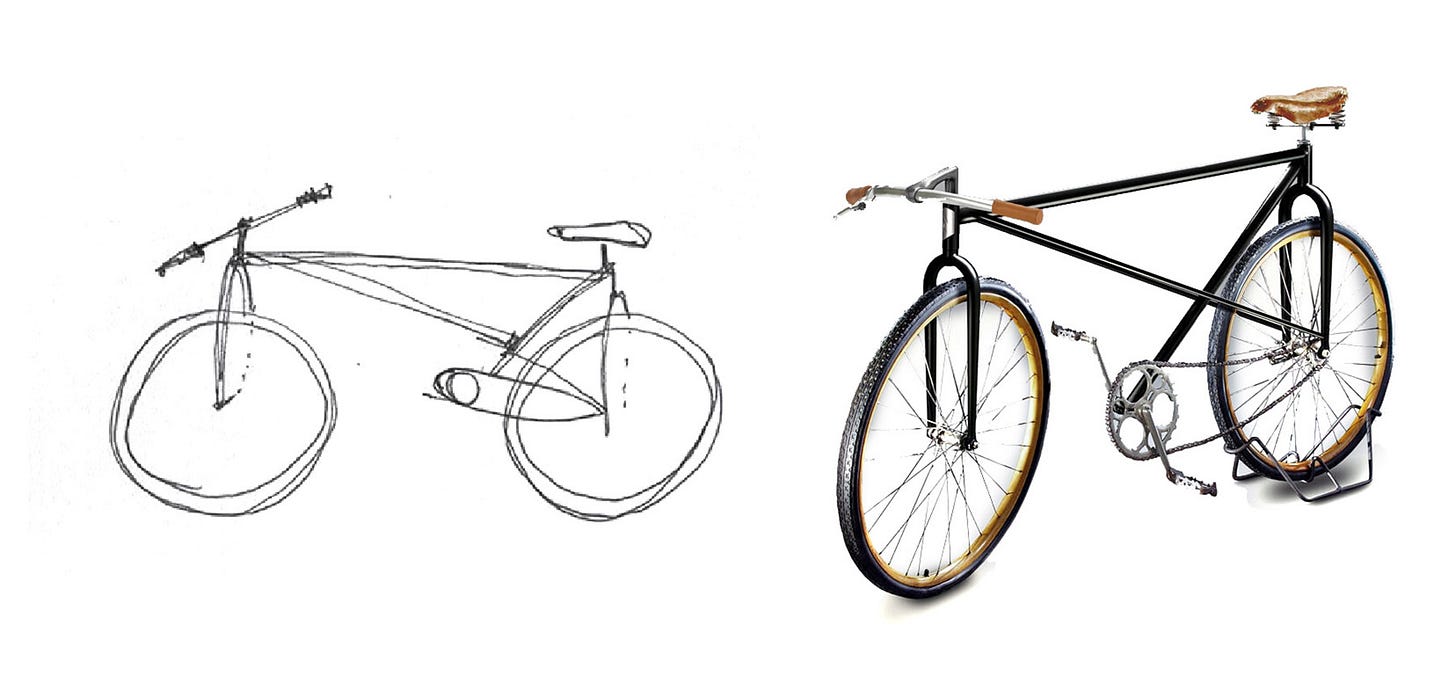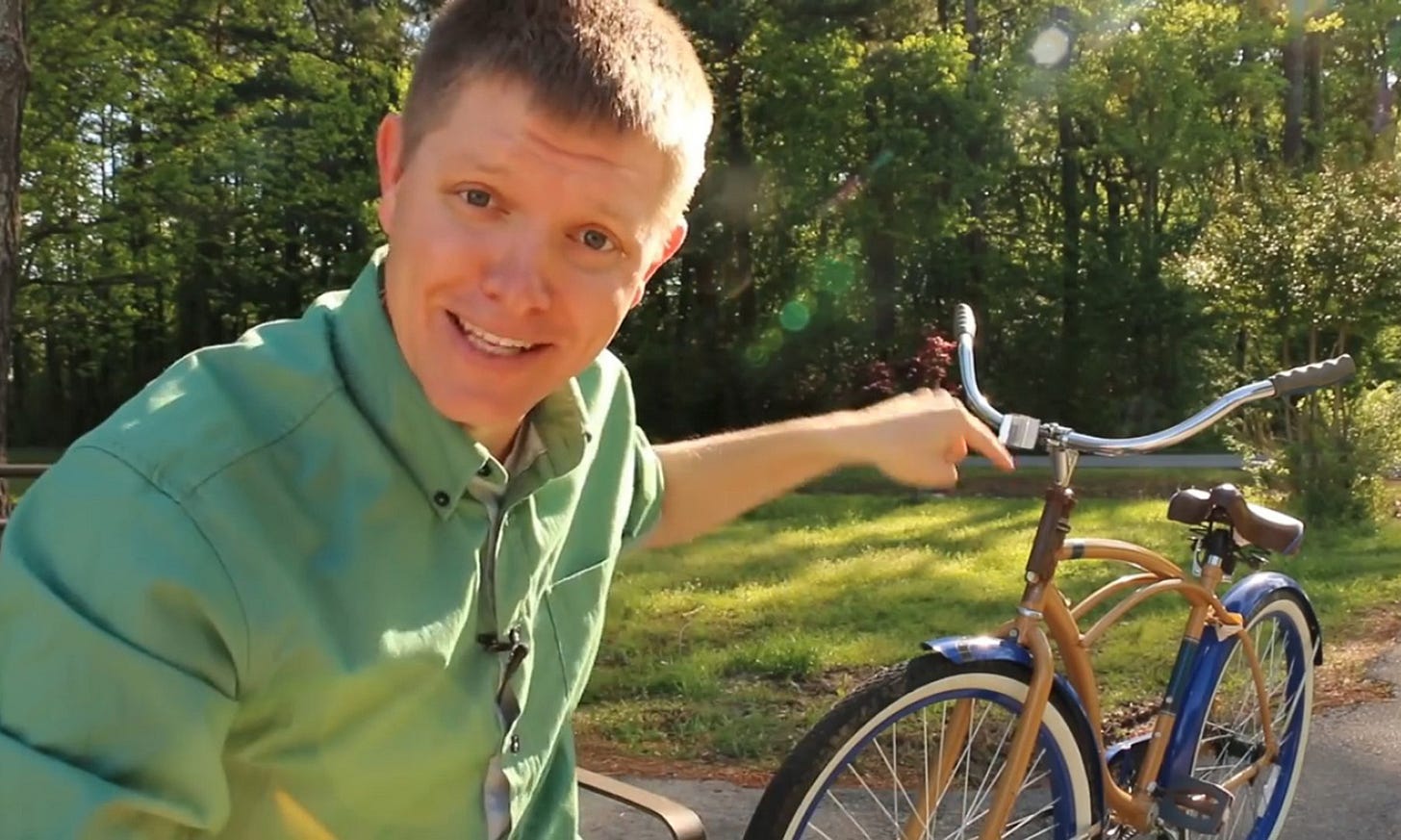Dear friends,
This week I get to share one of my favorite chapters from User Zero because I get to explain how to forget to ride a bike. In hindsight I’m surprised I managed to write about bikes and your mind without mentioning this Steve Jobs quote:
I read a study that measured the efficiency of locomotion for various species on the planet. The condor used the least energy to move a kilometer. And, humans came in with a rather unimpressive showing, about a third of the way down the list. It was not too proud a showing for the crown of creation. So, that didn’t look so good. But, then somebody at Scientific American had the insight to test the efficiency of locomotion for a man on a bicycle. And, a man on a bicycle, a human on a bicycle, blew the condor away, completely off the top of the charts. And that’s what a computer is to me. What a computer is to me is it’s the most remarkable tool that we’ve ever come up with, and it’s the equivalent of a bicycle for our minds.” – Steve Jobs
For me it’s been a nice summer full of bike rides and creative brain cycles. What more can anyone ask for? This Labor Day weekend I hope you get to spend more time on your bike than on your computer. Don’t forget your helmet though, we need to protect our idea factories. Stay creative.
Your friend,
– Ade
“Since the initial publication of the chart of the electromagnetic spectrum, humans have learned that what they can touch, smell, see, and hear is less than one-millionth of reality.” –Buckminster Fuller
If you think of your body as technology, your spec sheet is pretty impressive. You come equipped with twin cameras, stereo microphones, and a speaker. You have sensors that detect flavor, odor, heat, pressure, and position in space. Your power supply is rechargeable and lasts for 75 years. With proper maintenance it can last decades beyond its expected lifespan.
The control center for this technology rests in a sphere that swivels atop an omni-directional bipod. Like a computer, your head stores memories that can be retrieved at will. You can perform calculations and repeat basic functions. Your beliefs are an operating system of sorts. In chapter one, I described the write-access you have to your mind and the admin privileges you wield.
While it seems natural to describe our bodies as technology, we shouldn’t forget the order that things happened. We didn’t evolve into machines with computer-like abilities. Humans have always had amazing capabilities, we’ve just recently created machines that have similar capabilities as us. Does this distinction matter?
If our mind were a computer, programming it would involve mapping the inputs of our senses to sets of instructions that correspond with conditions that we detect. Our actions would be directed by collections of if then statements. “If loud, then cover ears. If it tastes good, then eat. If fire, then run.” Writing our mental software would be a process of mapping our sensory perceptions to outcomes. If this was how we learned, our software would get better with each condition that we add to our programs. Each exception to our rules would add new chains of logic to our decision trees. Here is a challenge. Try to describe a simple task, let’s say stacking blocks, using only sensory terms. It might sound like this...
First, use your eyeball sensors to look at the blocks. Second, use your touching sticks to squeeze the blocks. Apply upward pressure and rotate the block so that the bottom plane of the cube is parallel to the top plane of another cube. When your eyeballs see that the block is aligned, loosen your grip on the block until the touching sensation in your fingers goes away. Note, your sense of smell, sound, and taste can be in the “off” position for this exercise because you won’t be needing them.
These instructions might work for a machine, but to a normal person they are ridiculous. When a child stacks blocks, they are not perfecting a hard wired sensory system. They are constructing mental models. When the stack falls over they update their mental model to conform to a revised outlook on life.
The five senses lesson in school is a staple of early education. It is a dull, scientific way to explain the world in hindsight, a description of reality that misses the bigger picture. It is an idea virus, a sticky concept, the kind of principle that feels so unbreakable that questioning it as an adult feels like blasphemy. We seem to forget that we override our supposed “hard wiring” all the time. We are not limited by five senses. We are in control of the great sphere between our ears, the entirety of your universe, the only reality that matters, the world contained in your mind.
The throne you occupy at the pinnacle of your mind allows you to alter reality, but you have to realize it’s there, that it is a power you possess. Otherwise you are an animal. Humans are the dominant species because unlike other animals we can monitor our thoughts and intervene when our animal urges aren’t in our best interest. To be an animal is to act on impulse. An idea appears in your mind, not as a malleable thing, but as an instruction. The most dangerous philosophies are those that encourage you to act on your most primitive feelings. To transcend the animal, you must override your impulses and instincts.
Constraining your inputs to the five senses is like a muffler on your mind. It reduces you to a machine that is limited by primitive input mechanisms and rigid internal wiring. User zero is not hard wired. When you hear the term hard wired to describe human actions, ask yourself what the speaker has to gain from convincing you that you aren’t capable of controlling your own mind.
Often you will find that somebody else has something to gain by excusing your bad behavior. “If it feels good, you should do it.” We expect this kind of excusing from marketers and drug dealers but it seems odd that the hard wiring story is so similar to the five senses doctrine from grade school. What is gained by describing our bodies as input sensors?
An educational system that treats us like hard wired computers results in adults who believe we have been sufficiently programmed to handle whatever input life spits at us. Push the right buttons in the right sequence and everything will be fine. You have been treated like a programmable pattern recognition machine. The rise of mass production required reliable workforces. Knowledge from data injection is superficial and brittle compared to self-motivated learning but it is ideal for factory work. Education allowed factories to employ identical human machines to automate complex assembly patterns. When the world required assembly lines it made some sense to teach people to think like computers. We don’t live in that world any more. Today we have a glut of computers, but we are short on creative thinking.
Your mind is flexible, unlike your senses. If you lose one of your five senses you might be considered handicapped. And yet your mind is able to compensate for the weaknesses of your body. If you lose your sight, a BrainPort device can be attached to your tongue that lets you see because your brain can remap your sense of sight to your sense of taste. If you lose the ability of one of your senses you aren’t completely disabled. The bigger danger isn’t losing one of your senses, it is losing the control of your mind. And yet while none of us would voluntarily surrender one of our five senses, we routinely handicap our minds. We do it in obvious ways like through drugs and alcohol but we also do it in subtle ways. We stop learning after graduation. We accept shortcuts, crutches such as the five senses lesson and hard wiring mythology.
Our thoughts define our reality. Controlling our thoughts, in turn gives us the power to change our reality. But how do you change your thoughts? Ideas spring up seemingly from nowhere. Your brain filters out 99% of the data that is blasting your senses at any moment. The day after you buy a Fiat, the roads will magically seem to be filled with Fiats. Are there suddenly more Fiats in the world than yesterday? No, your attention has just been tuned to notice something that was previously invisible to you. The name for this phenomenon is reticular activation. You can’t realize that you have spent your entire life ignoring Fiats until after your brain has been activated to their existence and their upgraded relevance in your life.
Your reality is defined by a pre-conscious filter that selects what items are worthy of your attention. Our pattern recognition filter selects the “important” things and discards the rest without us realizing it. We are literally unaware of the things that our mind blocks from our attention.
It is easy to forget that the term blind spot comes from the physical design of our eyeballs. We have no vision in the spot where the optical nerve connects to the back of our eyes. Our mind paints over the holes, stitching together the missing parts. Our brain never allows us to know that anything is missing. It takes effort, a blind spot test, for us to believe that we aren’t seeing the complete picture.
Imagine a bicycle. Try to hold it in your mind, spin the pedals, turn the handlebars, and balance it on its two wheels. Now grab a sheet of paper and try to draw that bike that you just imagined. You will find that while the idea of a bike came effortlessly, translating that mental model into a real object was uncomfortable.
While most people (94% of Americans) know how to ride a bike, only 25% can accurately draw a bicycle. An art project by Gianluca Gimini cleverly demonstrated this gap. Gimini asked people to draw him a picture of a bicycle, and then he created 3D renderings based on these sketches. At first glance, the models look realistic, only slightly odd. It takes critical thinking to unwind the errors of the broken bikes and understand why they are unrideable.
At first glance, the bike-drawing project may seem like an unusual way to shame non-artists for their the lack of drawing skills, but the Bicycle Drawing Test is actually an established psychological tool used by clinicians to evaluate a person’s constructional ability in the absence of a physical model. Measuring how our mental maps connect to the physical world is a method of detecting how tuned to our surroundings we are. I have recreated some of the types of questions contained in the test on the opposite page. Most of us are much less connected than we perceive.
Compounding our over-estimation of the accuracy of our mental models is the under-estimation of how difficult it is to re-train our minds when presented with new facts. Destin Sandlin, engineer and creator of the Smarter Every Day video series, obtained a bicycle with a seemingly simple modification that reversed the direction of the handlebars. Turn the handlebars right and the wheel turned left. Turn the handlebars left and the wheel turned right. Despite knowing how to ride a bike and knowing the altered mechanics of this particular bike, Destin was unable to ride it even a few feet. Frustrated and embarrassed, Destin showed the bike to others to see how they performed. It wasn’t just him. Everyone who believed they could master the backwards bike failed.
Determined, Destin spent time every day practicing. It took him eight months before his mind released its strangle hold on the old way of riding a bike. Once he had mastered the altered version, something unexpected happened. When he went to ride a normal bicycle Destin discovered he could no longer do it. He became the first person in history to forget how to ride a bike. This story feels unbelievable because we perceive our minds as flexible. We are utterly fooled by an illusion that our knowledge equals understanding. We mistake our ability to use a tool with an ability to understand a tool.
Perhaps we can’t all draw a bike, but we can take comfort in the fact that we can ride a bike. That is where the value, lies, right? We don’t need to deeply understand a tool in order to gain utility from it. Besides, a bicycle is a simple machine compared to the luxuries of modern life. How can we possibly expect to possess deep knowledge when the complexity of our tools seems to be growing exponentially? The entire computing power that landed man on the moon is dwarfed by the smartphone in your pocket. At what point does this logic break down? Is there a tipping point where our lack of understanding ceases to improve our life and instead our exposure to risk steadily increases?
We carry crude mental sketches around, unaware of just how shallow our conceptual models are. Air conditioning, plumbing, electricity, refrigeration - we have vague understandings of how these things operate, but if we were forced to put pencil to paper would we be able to recreate this technology? Could you create a motor that spins from an electric current? Do you really understand how a speaker generates sound? Where does water pressure come from? How does a toilet flush? And if we can’t recreate the day-to-day luxuries, what hope do we have for addressing world-ending threats should they arise?
Our perceptions are that everything has been solved. We convince ourselves to purge the complexity from our minds and embrace a reality where all answers, should they arrive, are but a Google search away. We exist on the surface of objects, our consciousness rarely capable of connecting deeply to anything we touch.
There is a concept that will give us the vocabulary to describe our relationship with modern technology. It’s called opacity and it is the degree to which something is revealed or obscured from the senses. For our purposes, opacity is a spectrum with complete transparency on one side and impenetrable opaqueness on the other. On one side you have ready-to-eat grapes, on the other side you have black box systems like genomics or neuropsychology. Objects like bikes sit somewhere in between because although their parts are exposed for all to see, it takes mental effort to really understand them.
Penetrating the opaque requires mental leaps, user zero thinking. Those who are able to see the unseeable are the heroes of history. We immortalize Galileo, Newton, Einstein, and the scientists who unmasked the invisible laws of nature. Our most important inventors – Edison, Tesla, the Wright Brothers – conjured artifacts from the ether that defied what was believed possible. In the following chapters we will explore both the opaque and transparent sides of the opacity spectrum in search of ways to crack the opaque shell that throttles the input from our senses.
Can we regain the neural plasticity we had as children, return to a time before the wires of our sensory organs were welded to the inputs of modern technology? Next we will return to our childhood, step on to the playgrounds where we played when we were young. Here, in an environment designed specifically for kids, we might discover clues to how we’ve become so disconnected from our modern environments.
Thanks for reading. I am releasing User Zero one chapter at a time on Substack for free to all subscribers. Physical copies are available from Amazon. Stay creative.









